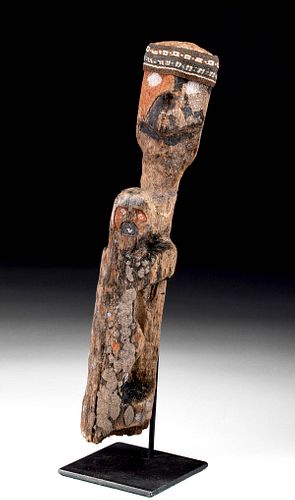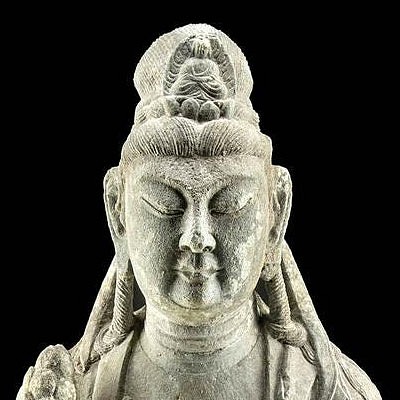Chancay Wood / Textile Sculpture - Mother & Child
Lot 33
About Seller
Artemis Fine Arts
686 S Taylor Ave, Ste 106
Louisville, CO 80027
United States
Selling antiquities, ancient and ethnographic art online since 1993, Artemis Gallery specializes in Classical Antiquities (Egyptian, Greek, Roman, Near Eastern), Asian, Pre-Columbian, African / Tribal / Oceanographic art. Our extensive inventory includes pottery, stone, metal, wood, glass and textil...Read more
Estimate:
$300 - $450
Absentee vs Live bid
Two ways to bid:
- Leave a max absentee bid and the platform will bid on your behalf up to your maximum bid during the live auction.
- Bid live during the auction and your bids will be submitted real-time to the auctioneer.
Bid Increments
| Price | Bid Increment |
|---|---|
| $0 | $25 |
| $300 | $50 |
| $1,000 | $100 |
| $2,000 | $250 |
| $5,000 | $500 |
| $10,000 | $1,000 |
| $20,000 | $2,500 |
| $50,000 | $5,000 |
| $100,000 | $10,000 |
| $200,000 | $20,000 |
About Auction
By Artemis Fine Arts
Sep 23, 2021
Set Reminder
2021-09-23 12:00:00
2021-09-23 12:00:00
America/New_York
Bidsquare
Bidsquare : Clearance Pre-Columbian, Asian, Ethnographic
https://www.bidsquare.com/auctions/artemis-gallery/clearance-pre-columbian-asian-ethnographic-7508
Consignor says sell! All lots priced to sell, with reserves now up to 75% off original starting prices. No hidden reserves. All lots will sell to the highest bidder. If you love Pre-Columbian, Asian or Ethnographic art this is one auction you don't want to miss. Artemis Fine Arts info@artemisgallery.com
Consignor says sell! All lots priced to sell, with reserves now up to 75% off original starting prices. No hidden reserves. All lots will sell to the highest bidder. If you love Pre-Columbian, Asian or Ethnographic art this is one auction you don't want to miss. Artemis Fine Arts info@artemisgallery.com
- Lot Description
**Originally Listed At $450**
Pre-Columbian, Central Coast Peru, Chancay, ca. 1000 CE. A hand-carved and painted wooden maternal pair. The mother's visage is delineated with characteristically diamond-shaped white eyes, a protruding nose, petite white lips, red and black face paint, and a textile cap finely woven from camelid (alpaca or llama) fibers. The child's face is rendered with delicate features and nice remains of red,white, and black pigmentation. A touching portrayal of the bond between a mother and her child from the Chancay culture. Size: 3.125" W x 18" H (7.9 cm x 45.7 cm); 19.4" H (49.3 cm) on included custom stand.
Provenance: private Hawaii, USA collection; ex-private Hans Juergen Westermann collection, Germany, collected from 1950 to 1960s
All items legal to buy/sell under U.S. Statute covering cultural patrimony Code 2600, CHAPTER 14, and are guaranteed to be as described or your money back.
A Certificate of Authenticity will accompany all winning bids.
PLEASE NOTE: Due to recent increases of shipments being seized by Australian & German customs (even for items with pre-UNESCO provenance), we will no longer ship PLEASE NOTE: Due to recent increases of shipments being seized by Australian & German customs (even for items with pre-UNESCO provenance), we will no longer ship most antiquities and ancient Chinese art to Australia & Germany. For categories of items that are acceptable to ship to Australia or Germany, please contact us directly or work with your local customs brokerage firm.
Display stands not described as included/custom in the item description are for photography purposes only and will not be included with the item upon shipping.
#156962Head of larger figure reattached along neck, with light in-fill material and adhesive residue along break lines. Loss to left half of base as shown. Textile headband is perhaps not original to the larger figure but is from the same time period. Encrustations across both figures, with chipping and splintering in several areas, and minor fading to pigmentation. Nice remains of pigment across obverse and great earthen deposits throughout.Condition
- Shipping Info
-
All shipping is handled in-house for your convenience. Your invoice from Artemis Gallery will include shipping calculation instructions. If in doubt, please inquire BEFORE bidding for estimated shipping costs for individual items.
-
- Buyer's Premium



 EUR
EUR CAD
CAD AUD
AUD GBP
GBP MXN
MXN HKD
HKD CNY
CNY MYR
MYR SEK
SEK SGD
SGD CHF
CHF THB
THB















